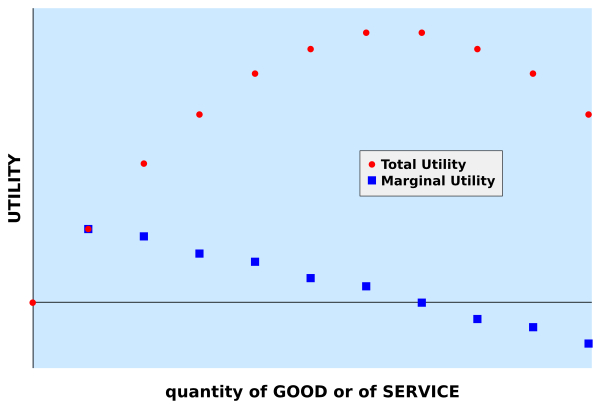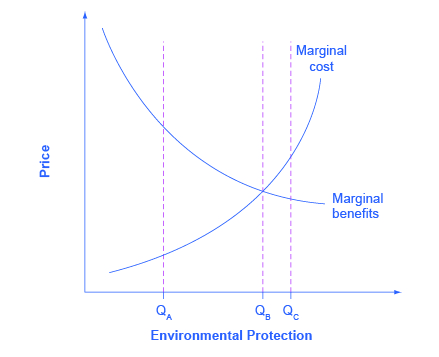Scarcity Leads to Tradeoffs and Choice
When scarce resources are used, actors are forced to make choices that have an opportunity cost.
Learning objectives
Give examples of economic trade-offs.
A fundamental concept in economics is that of scarcity. In contrast to its colloquial usage, scarcity in economics connotes not that something is nearly impossible to find, but simply that it is not unlimited. For example, the number of available hours in a day is a scarce resource: there is a finite amount of time available to you to do work, hang out with friends, and relax. Most resources are scarce in most situations.
Since resources tend to be scarce, anyone that uses the resource has to make a decision about how to use it. Suppose, for example, that you are a drink manufacturer. To produce a beverage, you have to use some scarce resources: the plastic for the bottle, the workers’ time, a machine to fill the bottles, etc. If you choose to make one bottle of water, you have chosen to not make a bottle of soda. Your scarce resources force you to make a choice and a trade-off producing one product or another.

Tradeoffs: Since resources are scarce for a drink manufacturer, it must make a tradeoff between producing bottles of water and bottles of soda.
Like producers, consumers also have to make choices. Often, consumers must choose between current consumption (“I want to buy an ice cream”) and future consumption (“I should rather save my money so I can buy an ice cream tomorrow”). Since consumers’ resources such as time, attention, and money are limited, they must choose how to best allocate them by making tradeoffs.
The concept of trade-offs due to scarcity is formalized by the concept of opportunity cost. The opportunity cost of a choice is the value of the best alternative forgone. In other words, if you can only produce bottles of soda and water, the opportunity cost of producing a bottle of water is the value of producing a bottle of soda. Similarly, there is an opportunity cost in everything: the opportunity cost of you reading this is what you could be doing with your time instead (say, watching a movie). When scarce resources are used (and just about everything is a scarce resource), people and firms are forced to make choices that have an opportunity cost.
Individuals Face Opportunity Costs
Individuals face opportunity costs when they choose one course of action over another.
Learning objectives
Distinguish between explicit costs and opportunity costs
When individuals make decisions, they are necessarily deciding between taking one course of action over another. In doing so, they are choosing both what to do and, by extension, what not to do. The value of the next best choice forgone is called the opportunity cost. In other words, the opportunity cost of a course of action is the value the of the option that the individual chose not to take.
Individuals face opportunity costs in both economic and non-economic decisions. One of the easiest way to imagine an individual’s opportunity costs is to imagine a student who decides to study. By choosing to study, the student is implicitly choosing to not go to a party, hang out with friends, or catch up on some much-needed sleep. In this example, the opportunity cost is not easily expressed in dollars and cents, but is just as real.

Opportunity Cost: By choosing to go to spend time and money on things like classes and computers, you are necessarily choosing not to spend it on something else, like going on vacation. This is an opportunity cost.
Rational individuals will try to minimize their opportunity costs. By doing so, individuals are maximizing the amount that they can get out of their resources (time, money, effort, etc.). This makes sense: individuals should seek to get the most and give up the least.
As economic actors, individuals face opportunity costs as well. For example, suppose you decide to purchase a new computer. You could have chosen to spend your money on books or rent or a spring break trip; whichever one of those options is most valuable to you (beside purchasing a new computer) is the opportunity cost.
Such logic applies for every economic decision: purchasing one good means that an individual has chosen to spend resources one way instead of another. Opportunity costs are an important consideration for economists and business people, but are faced by individuals even when they are not making classically economic decisions.
Individuals Make Decisions at the Margins
Individuals will choose the option that yields the greatest net marginal benefit.
Learning objectives
Apply the concepts of marginal analysis and utility to decision-making
When individuals make decisions, they do so by looking at the additional cost and benefit of the decision. The cost or benefit of the single decision is called the marginal cost or the marginal benefit. This is different from the total or average: net marginal benefit (marginal benefit minus marginal cost) is the amount that total benefit will change due to the single decision. For example, if the cost of making 9 pieces of pizza is $90 and the cost of making 10 pieces is $110, the marginal cost of producing the tenth piece of pizza is $20. In theory, individuals will only choose an option if marginal benefit exceeds marginal cost.

Marginal and Total Utility: Marginal utility is the amount that a certain action will change total utility. Individuals use net marginal utility to make decisions.
Let’s take an example. Suppose you are buying a car and have three choices:
- Car A, which costs $10,000
- Car B, which costs $12,000
- Car C, which costs $15,000
The prices represent the marginal costs of each car; purchasing the car will add the cost of the car to your total costs. Also suppose Car A provides you $15,000 worth of utility, Car B provides $15,000, and Car C provides $25,000. Those utilities, in dollar terms, are the marginal benefit of each car.
In order to make the decision, you look at the marginal cost and marginal benefit of each car. By subtracting the cost from the benefit, Car A offers $5,000 of marginal benefit, Car B offers $3,000, and Car C offers $10,000. Obviously, Car C is the best choice because, at the margins, it offers the most benefit to you.
Note that you are concerned not with your total or average cost and benefit (assuming no resource or other external restrictions), but with the marginal cost and benefit. As a decision maker, you want to know how much the decision will change your current state, so you look at the margins, not the overall picture. That is not to say that things like the total cost are unimportant, but that, assuming there are enough resources, individuals will look at the marginal change each option will provide to his/her life or to the firm and chose the one with the greatest net marginal benefit.
Marginal Benefits and Costs for Pollution
The tools of marginal analysis can illustrate the marginal costs and the marginal benefits of reducing pollution. When the quantity of environmental protection is low (quantity QaQa) and pollution is extensive, there are cheap and easy ways to reduce pollution, and the marginal benefits of doing so are quite high. At QaQa, it makes sense to allocate more resources to fight pollution.
However, as environmental protection increases, the cheap and easy ways of reducing pollution decrease, and pollution can only be reduced with costly methods. In other words, the largest marginal benefits are achieved first, followed by decreasing marginal benefits. As the quantity of environmental protection increases to QbQb, the gap between marginal benefits and marginal costs decreases. At point QcQc, the marginal costs will exceed the marginal benefits. At this level of environmental protection, society is not allocating resources efficiently, because too many resources are being given up to reduce pollution.

Marginal Costs and Marginal Benefits of Environmental Protection: Reducing pollution is costly—resources must be sacrificed. The marginal costs of reducing pollution are generally increasing, because the least expensive and easiest reductions can be made first, leaving the more expensive methods for later. The marginal benefits of reducing pollution are generally declining, because the steps that provide the greatest benefit can be taken first, and steps that provide less benefit can wait until later.
Individuals Respond to Incentives
Incentives are ways to encourage or discourage certain behaviors or choices.
Learning objectives
Predict how pay incentives will influence a person’s work performance
An incentive is something that motivates an individual to perform an action. The study of incentive structures is central to the study of all economic activities (both in terms of individual decision-making and in terms of cooperation and competition within a larger institutional structure).
Perhaps the most notable incentive in economics is price. Price acts as a signal to suppliers to produce and to consumers to buy. For example, a sale is nothing more than a store providing an incentive to potential customers to buy. The lowering of the price makes the purchase a better idea for some customers; the sale seeks to persuade individuals to change their actions (namely, to buy the product).

Sales are Incentives: Sales are incentives for consumers to buy, because firms know consumers generally respond to lower prices by purchasing more.
Similarly, the increase in price acts as an incentive to suppliers to produce more of a good. If suppliers think they can sell their products for more, they will be inclined to produce more. The price acts, therefore, as an incentive to customers to buy and suppliers to produce.
Types of Incentives
Incentives come in many other forms, however. Broadly, most incentives can be grouped into one of four categories:
- Remunerative incentives: The incentive comes in the form of some sort of material reward – especially money – in exchange for acting in a particular way. Wages, prices, and bribery are all examples of remunerative incentives. This is the type of incentive that is typically associated with economics.
- Moral incentives: This occurs when a certain choice is widely regarded as the right thing to do, or as particularly admirable, or where the failure to act in a certain way is condemned as indecent. Societies and cultures are two main sources of moral incentives.
- Coercive incentives: The incentive is a promise of some sort of punishment if the wrong decision is made. For example, the promise of imprisonment is a coercive incentive for people to not steal.
- Natural Incentives: Things such as curiosity, mental or physical exercise, admiration, fear, anger, pain, joy, the pursuit of truth, and a sense of control of people or oneself can cause individuals to make certain decisions.
Economics is mainly concerned with remunerative incentives, though when discussing government regulations, coercive incentives often come into play. By manipulating incentives, individuals (as well as businesses and governments) hope to encourage some behaviors and discourage others.
Incentives and Performance
Companies leverage incentives-based strategies to drive performance and optimize employee decision-making and behaviors through meaningful reward systems. While there are both advantages and drawbacks to this type of approach, remunerative (financial) incentives are highly attractive options for employers in a variety of industries and businesses. Providing incentives such as variable income, where an individual can obtain more personal rewards for successfully creating a product or making a sale, often drives up production for highly motivated employees.
An example of this would be a manufacturing facility making widgets. The floor manager shifts the wage system from an hourly wage perspective to a straight piece rate system. The more widgets a worker creates, the higher his or her prospective income will be. Under this incentive system less productive workers may stay the same, but highly productive workers will respond by increasing their production.
Key Points
- Scarce resources diminish as they are used and almost all resources are scarce.
- In order to use a scarce resource, you are inherently using the resource for one purpose and not an alternative.
- The cost of using a resource is called the opportunity cost: the value of the next best alternative that you could be using the resource for instead.
- The opportunity cost is the value of the next best alternative foregone.
- Every decision necessarily means giving up other options, which all have a value.
- The opportunity cost is the value one could have derived from using the same resources another way, though this is not always easily quantifiable.
- The marginal cost or benefit is the amount that a decision will change the total cost or benefit from where it is currently.
- Individuals will make choice that maximizes the net marginal benefit (marginal benefit – marginal cost).
- While total or average cost and benefit are important, provided enough resources, individuals will look only at the net marginal benefit.
- Price is one of the main incentives studied in economics. Price incentivizes producers to supply a certain amount, and consumers to purchase a certain amount.
- Economics is mainly concerned with studying remunerative incentives (those that concern material reward).
- Individuals, firms, and governments all change incentives in hopes of encouraging desired outcomes.
Key Terms
- Scarce: Insufficient to meet demand.
- Opportunity cost: The value of the best alternative forgone.
- Opportunity Costs: The value of the best alternative forgone, in a situation in which a choice needs to be made between several mutually exclusive alternatives given limited resources.
- marginal benefit: The additional benefit from taking a course of action.
- marginal cost: The additional cost from taking a course of action.
- incentive: Something that motivates an individual to perform an action.
- Incentive Structure: The cumulative set of promised rewards and/or punishments that encourage actors to make a set of decisions.
LICENSES AND ATTRIBUTIONS
CC LICENSED CONTENT, SPECIFIC ATTRIBUTION
- Opportunity cost. Provided by: Wikipedia. Located at: en.Wikipedia.org/wiki/Opportunity_cost. License: CC BY-SA: Attribution-ShareAlike
- Steven Hinson, The Invisible Hand and Allocative Efficiency. October 18, 2013. Provided by: OpenStax CNX. Located at: http://cnx.org/content/m42970/latest/. License: CC BY: Attribution
- Microeconomics/Goods and Scarcity. Provided by: Wikibooks. Located at: en.wikibooks.org/wiki/Microec...s_and_Scarcity. License: CC BY-SA: Attribution-ShareAlike
- Scarce. Provided by: Wiktionary. Located at: en.wiktionary.org/wiki/Scarce. License: CC BY-SA: Attribution-ShareAlike
- Opportunity cost. Provided by: Wiktionary. Located at: en.wiktionary.org/wiki/Opportunity+cost. License: CC BY-SA: Attribution-ShareAlike
- Steven Hinson, The Invisible Hand and Allocative Efficiency. October 18, 2013. Provided by: OpenStax CNX. Located at: http://cnx.org/content/m42970/latest/. License: CC BY: Attribution
- Principles of Economics/Opportunity Costs. Provided by: Wikibooks. Located at: en.wikibooks.org/wiki/Princip...ortunity_Costs. License: CC BY-SA: Attribution-ShareAlike
- Microeconomics/Opportunity Cost. Provided by: Wikibooks. Located at: en.wikibooks.org/wiki/Microec...portunity_Cost. License: CC BY-SA: Attribution-ShareAlike
- Amy Ando, Evaluating Projects and Policies. October 31, 2013. Provided by: OpenStax CNX. Located at: http://cnx.org/content/m38611/latest/. License: CC BY: Attribution
- Opportunity cost. Provided by: WIKIPEDIA. Located at: en.Wikipedia.org/wiki/Opportunity_cost. License: CC BY-SA: Attribution-ShareAlike
- Opportunity Costs. Provided by: Wikipedia. Located at: en.Wikipedia.org/wiki/Opportunity%20Costs. License: CC BY-SA: Attribution-ShareAlike
- Steven Hinson, The Invisible Hand and Allocative Efficiency. October 18, 2013. Provided by: OpenStax CNX. Located at: http://cnx.org/content/m42970/latest/. License: CC BY: Attribution
- Caneel Bay Turtle Bay Beach 4. Provided by: Wikimedia. Located at: commons.wikimedia.org/wiki/Fi...ay_Beach_4.jpg. License: CC BY-SA: Attribution-ShareAlike
- The Benefits and Costs of U.S. Environmental Laws. Provided by: Principles of Economics by Phil Schatz. Located at: http://philschatz.com/economics-book...ts/m48672.html. License: CC BY: Attribution
- Marginal analysis - Marginal Benefit including marginal revenue and Marginal cost. Provided by: MicroEcon201. Located at: microecon201.wikispaces.com/M...Marginal++cost. License: CC BY-SA: Attribution-ShareAlike
- Macroeconomics/Economics. Provided by: Wikibooks. Located at: en.wikibooks.org/wiki/Macroec...ginal_analysis. License: CC BY-SA: Attribution-ShareAlike
- Principles of Economics/Marginal Utility. Provided by: Wikibooks. Located at: en.wikibooks.org/wiki/Princip...rginal_Utility. License: CC BY-SA: Attribution-ShareAlike
- marginal benefit. Provided by: Wiktionary. Located at: en.wiktionary.org/wiki/marginal_benefit. License: CC BY-SA: Attribution-ShareAlike
- marginal cost. Provided by: Wiktionary. Located at: en.wiktionary.org/wiki/marginal_cost. License: CC BY-SA: Attribution-ShareAlike
- Steven Hinson, The Invisible Hand and Allocative Efficiency. October 18, 2013. Provided by: OpenStax CNX. Located at: http://cnx.org/content/m42970/latest/. License: CC BY: Attribution
- Caneel Bay Turtle Bay Beach 4. Provided by: Wikimedia. Located at: commons.wikimedia.org/wiki/Fi...ay_Beach_4.jpg. License: CC BY-SA: Attribution-ShareAlike
- UtilityQuantified. Provided by: Wikimedia. Located at: commons.wikimedia.org/wiki/Fi...Quantified.svg. License: CC BY-SA: Attribution-ShareAlike
- Marginal Costs and Marginal Benefits of Environmental Protection. Provided by: Principles of Economics. Located at: http://philschatz.com/economics-book...ts/m48672.html. License: CC BY-SA: Attribution-ShareAlike
- Managing Groups and Teams/Which attributes are fundamental to team cohesion?. Provided by: Wikibooks. Located at: en.wikibooks.org/wiki/Managin...n?%23Incentive. License: CC BY-SA: Attribution-ShareAlike
- Incentive. Provided by: Wikipedia. Located at: en.Wikipedia.org/wiki/Incentive. License: CC BY-SA: Attribution-ShareAlike
- Amy Ando, Solutions: Property Rights, Regulations, and Incentive Policies. November 1, 2013. Provided by: OpenStax CNX. Located at: http://cnx.org/content/m38956/latest/. License: CC BY: Attribution
- incentive. Provided by: Wiktionary. Located at: en.wiktionary.org/wiki/incentive. License: CC BY-SA: Attribution-ShareAlike
- Boundless. Provided by: Boundless Learning. Located at: www.boundless.com//economics/...tive-structure. License: CC BY-SA: Attribution-ShareAlike
- Steven Hinson, The Invisible Hand and Allocative Efficiency. October 18, 2013. Provided by: OpenStax CNX. Located at: http://cnx.org/content/m42970/latest/. License: CC BY: Attribution
- Caneel Bay Turtle Bay Beach 4. Provided by: Wikimedia. Located at: commons.wikimedia.org/wiki/Fi...ay_Beach_4.jpg. License: CC BY-SA: Attribution-ShareAlike
- UtilityQuantified. Provided by: Wikimedia. Located at: commons.wikimedia.org/wiki/Fi...Quantified.svg. License: CC BY-SA: Attribution-ShareAlike
- Marginal Costs and Marginal Benefits of Environmental Protection. Provided by: Principles of Economics. Located at: http://philschatz.com/economics-book...ts/m48672.html. License: CC BY-SA: Attribution-ShareAlike
- Sale sign. Provided by: Wikimedia. Located at: commons.wikimedia.org/wiki/File:Sale_sign.jpg. License: CC BY-SA: Attribution-ShareAlike







